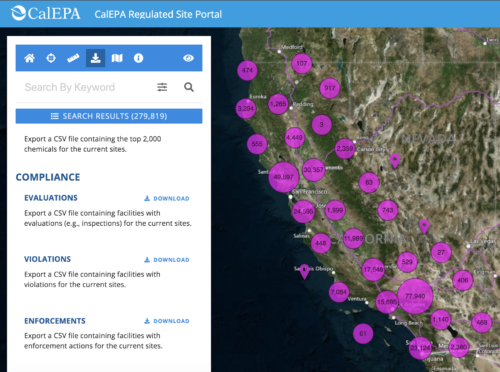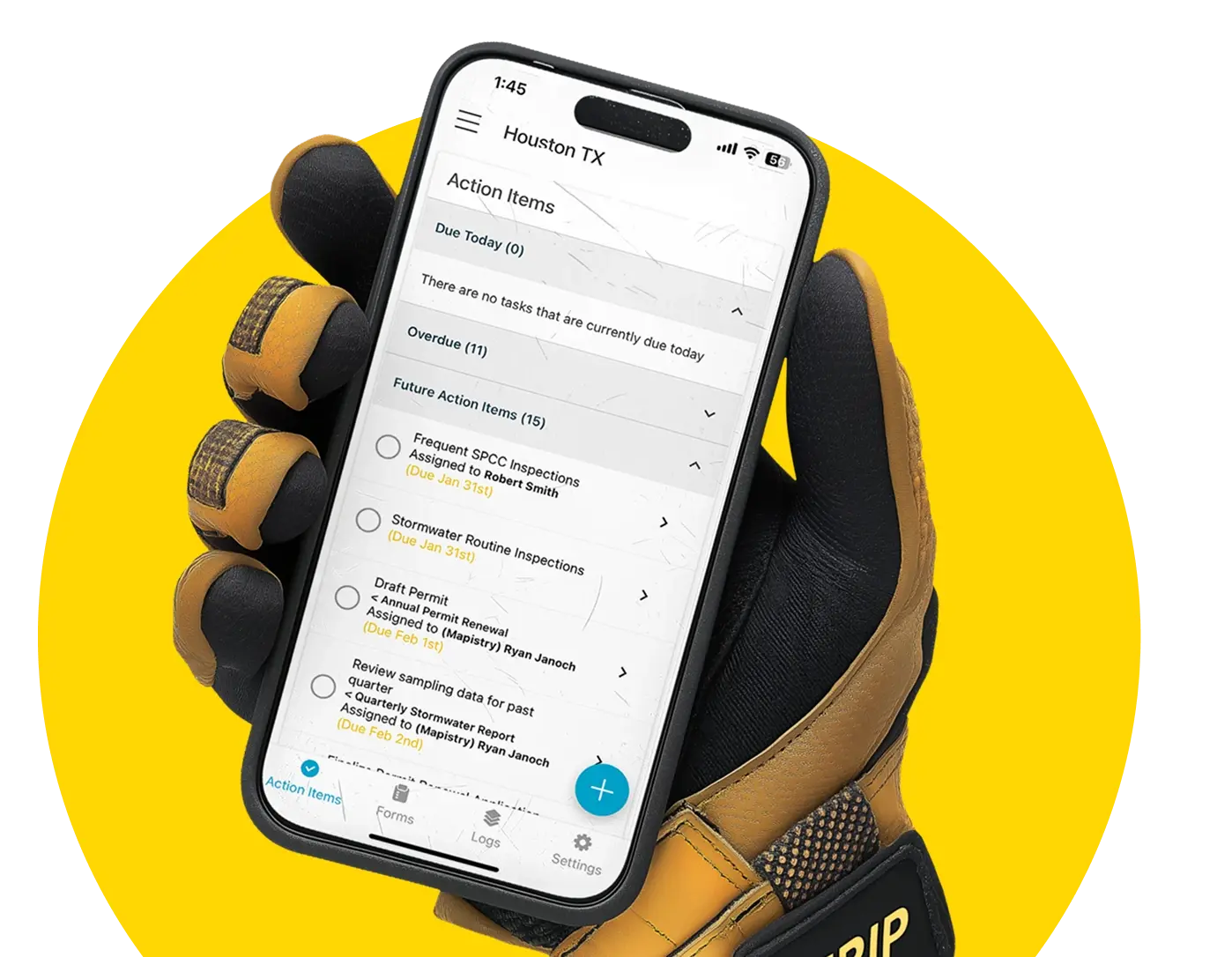Top 5 CUPA HazMat & SPCC Violations of 2018 and How Mapistry Can Prevent Them
2018 was a big year: the royal wedding, mid-term elections, and the World Cup were among the top trending stories. But what was trending in the realm of environmental compliance enforcement? To uncover the top environmental violations of 2018,
Mapistry’s data team dove in more than 124,000 violations documented by the Certified Unified Program Agencies (CUPA) in California. CUPA is a group of local agencies certified by the California Environmental Protection Agency (CalEPA) to monitor and enforce environmental regulations throughout California. Each agency within CUPA oversees the following six programs within their respective jurisdiction:
-
Hazardous Materials Business Plan (HMBP) Program
-
California Accidental Release Prevention (CalARP) Program
-
Hazardous Waste Generator Program
-
Aboveground Storage Tank (AST) Program
-
Underground Storage Tank (UST) Program
-
California Fire Code
-
Hazardous Materials Management Plans
-
Hazardous Materials Inventory Statements
-
CalEPA’s New Public Regulated Site Portal
In order to provide a consistent regulatory program for the 82 CUPA jurisdictions across California, the CalEPA set up a centralized eReporting platform called California Environmental Reporting System (CERS) to submit and certify regulatory documents online. More recently, the CERS eReporting data is funneled into a public portal that maps out regulated facility locations, violations, and enforcement actions. Take a peek at your facilities (before the environmental groups do): https://siteportal.calepa.ca.gov .
The CalEPA’s new Regulated Site Portal where facility evaluations, violations, and enforcement actions are publicly displayed.
What is the Risk of Receiving a Violation?
In 2018, 23% of registered facilities received at least one violation. On average, a facility received 4 violations. In this article, we’ll go through the five most common violations, which comprised 40% of all violation citations in 2018. By ensuring these five items are checked off your list, your facilities will be well on their way to passing their CUPA inspection with flying colors (and zero fines).
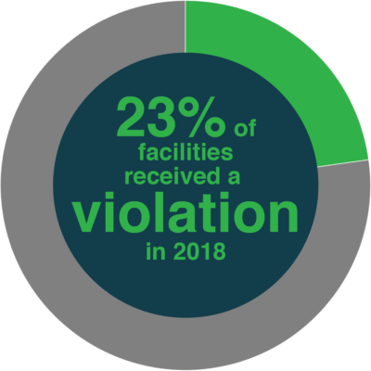
Now, let’s count down the top five violations…

5. Inadequate SPCC Program
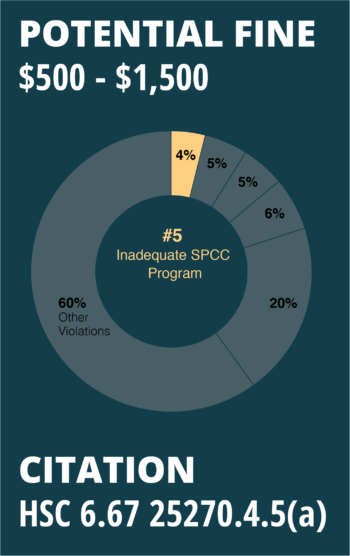
If you think CUPA inspectors are only onsite to inspect hazardous materials, think again. The fifth-most common CUPA violation was related to the Aboveground Petroleum Storage Act (APSA) Program. These violations made up nearly 4% of all CUPA violations and potentially resulted in fines up to $1,500. When a CUPA inspector inspects your facility, he or she will typically ask to see your Spill Prevention, Control, and Countermeasure (SPCC) plan if the volume of oil on your site exceeds the regulatory threshold.
In implementing the APSA program, the local CUPAs are required to review SPCC plans and ensure that such plans have been prepared in compliance with APSA and federal SPCC Plans. The SPCC plan should be up-to-date, accurately reflect the current site conditions, and include training records for oil-handling staff. Does your staff know where to find the SPCC plan?
Description of Violations
Some common violations listed under this citation included:
-
Failure to prepare an SPCC Plan.
-
Failure to implement the SPCC Plan.
-
Failure to provide training to all oil-handling personnel.
-
Failure to maintain a complete copy of the SPCC Plan at the facility.
-
Failure to ensure that tanks are inspected and tested in accordance with industry standards.
-
Failure to discuss in the SPCC Plan procedures to test or inspect each aboveground container.
Prevention
Step one is to ensure each of your facilities has an up-to-date and signed SPCC plan. Mapistry provides a clean, user-friendly platform to quickly click through each facility’s dashboard to view and/or download the facility’s SPCC plan. Use the platform to either upload your current SPCC plan or develop and maintain a digital SPCC plan via the SPCC plan builder.
SPCC Plan Builder
Mapistry’s SPCC Suite includes built-in controls to automate the development and management of your mandatory SPCC Plans, including the required site map. The platform includes tools to log and update tank locations, spill kits, and loading areas and outlines how to document your facility’s containment methods and best practices.
SPCC eLearning Course
Additionally, Mapistry offers an SPCC eLearning course to train facility staff on preventative SPCC measures and how to respond if a spill does occur. The customizable course gamifies learning by including rich graphics, professional narration, and engaging interactions. Plus the course can be completed in under 30 minutes!
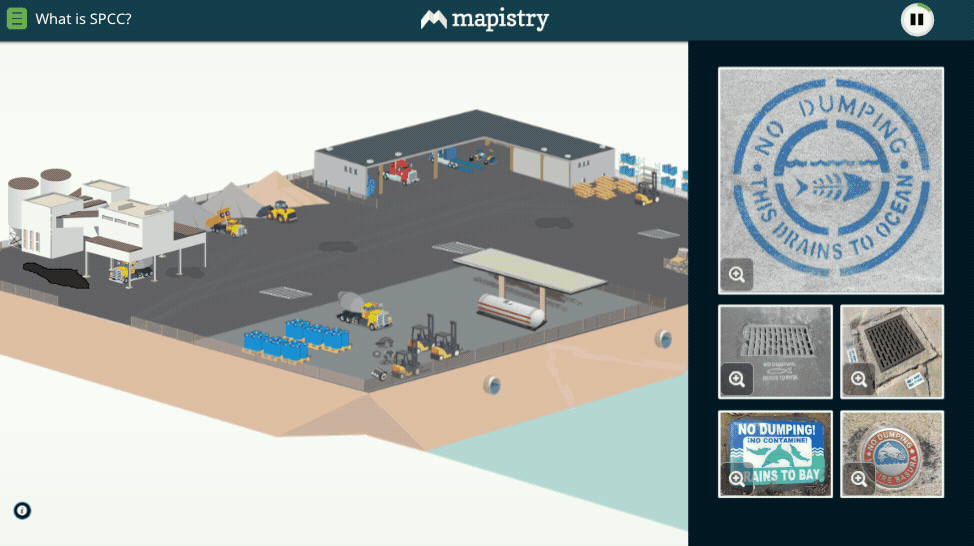
A scene from Mapistry’s SPCC eLearning course designed to train facility staff on preventative SPCC measures.
4. Inadequate HazMat Training
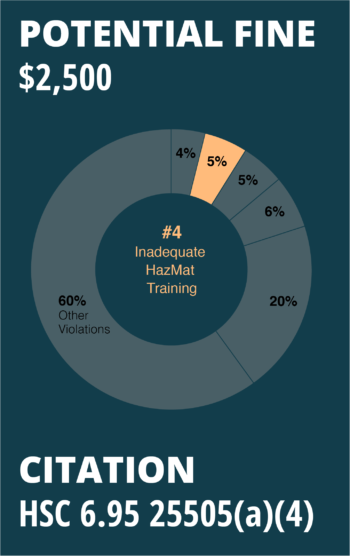
Coming in at number four, inadequate training on preparedness for an accidental release of a hazardous substance comprised 5% of violations. That included either not providing training to staff or not retaining training records for the required 3-year term. This violation had the most expensive potential fine of $2,500.
Description of Violations
Some common violations listed under this citation included:
-
Failure to provide initial and annual training to all employees in safety procedures in the event of a release or threatened release of a hazardous material.
-
Failure to document and maintain training records for a minimum of three years.
Prevention
Mapistry’s eLearning suite has added a HazMat eLearning course onto the product roadmap. Due out in Fall 2019, the HazMat course aims to give an overview of hazardous materials compliance. Learning objectives include container requirements, emergency response, and chemical basics.
The advantages to eLearning include a centralized management platform to track training records across facilities, a self-paced and interactive learning experience for each individual, and it eliminates the need for all trainees to be in the same place at once. The eLearning allows for training to occur as part of onboarding a new hire to the facility instead of only occurring once a year.
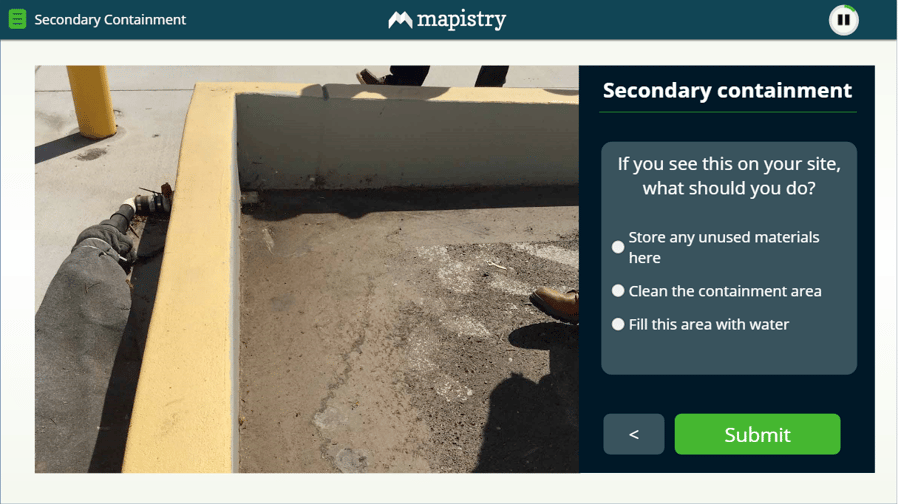
Scheduled for release in Fall 2019, Mapistry’s HazMat eLearning course gives trainees an overview of hazardous materials compliance.
3. Inadequately Labeled Haz Waste Accumulation Areas
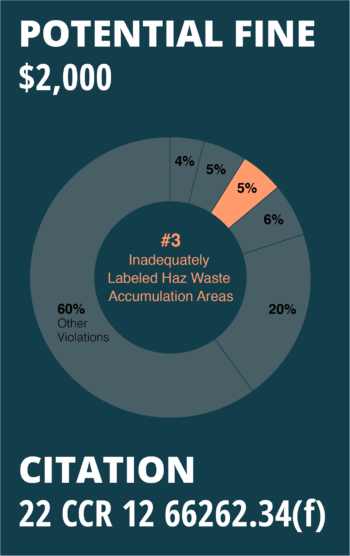
Inadequately labeled hazardous waste accumulation areas resulted in a hefty potential fine of $2,000 and accounted for more than 5% of all 2018 violations. Satellite accumulation areas should be properly labeled to know what is being stored and when the accumulation period began so the material can be disposed of in accordance with regulations. Specifically, the labels should list:
-
“Hazardous Waste”,
-
name and address of the generator,
-
physical and chemical characteristics of the Hazardous Waste, and
-
starting accumulation date.
Description of Violations
Some common violations listed under this citation included:
-
Failure to properly label hazardous waste accumulation containers and portable tanks.
-
Failure to label stationary hazardous waste tanks as “hazardous waste” and mark with an accumulation start date.
Prevention
Mapistry’s hazardous materials suite includes the ability to map container locations and log a photo of the label. Additionally, a site-specific hazardous material inspection form is generated from locations on the map providing another layer of defense – ensuring site staff are inspecting labels and containers regularly.
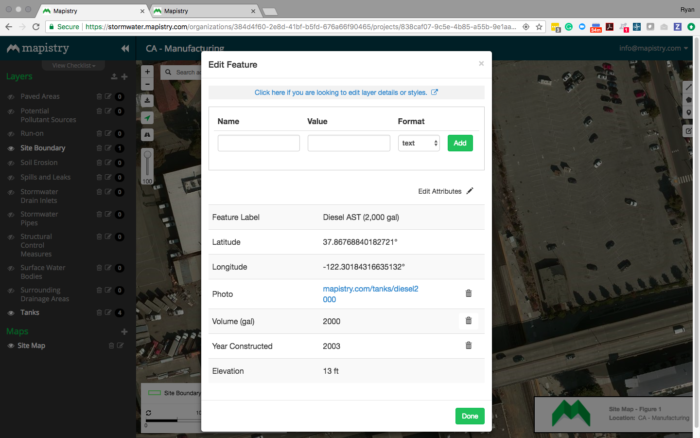
Mapistry’s Hazardous Materials Suite includes the ability to map container locations and log a photo of the label.
2. Failure to Annually Update the HMBP
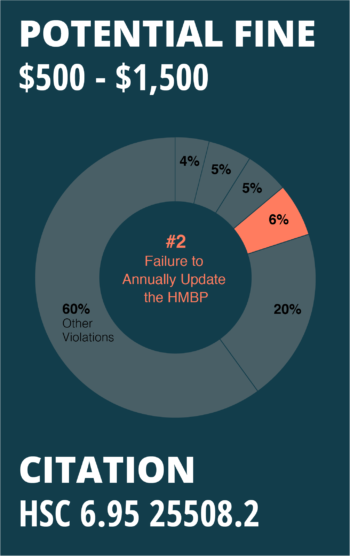
It may seem simple, but the number two most-common violation was failing to annually review and certify the HMBP on time. Not annually updating the HMBP accounted for nearly 6% of all violations. While walking from chemical cabinet to chemical cabinet to update your chemical inventory may not be a walk in the park, Mapistry’s digital tools for maintaining your chemical inventory can make the burden more bearable.
Description of Violations
This violation was described as failure to annually review and electronically certify that the business plan is complete, accurate, and up-to-date on or before the annual due date.
Prevention
Mapistry’s Hazardous Materials Suite includes the ability to upload and maintain the facility’s chemical inventory. Create a digital record of all your tools and equipment involved in hazardous materials handling. Additionally, as you drop chemical locations in the map, a consolidated chemical inventory is generated in the chemical table. Once all your chemicals have been added to the map, staff can painlessly download the chemical table from Mapistry directly into the CERS excel format – no more formatting or updating spreadsheets!

A digital chemical inventory created using Mapistry’s Hazardous Materials Suite.
1. Failure to Submit a Complete HMBP and Site Map
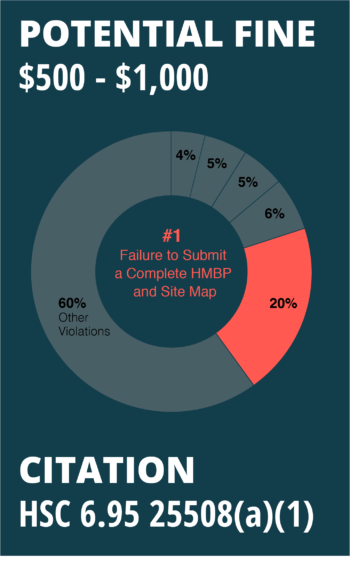
- Finally (drumroll please), the most common CUPA violation of 2018 goes to: failing to submit a complete HMBP that includes all required materials. This violation accounts for a whopping 20% of all violations! The HMBP may be incomplete because it does not contain all hazardous materials, does not include a site map, doesn’t outline an adequate training program, etc.
Description of Violations
- A summary of the violations listed under this citation includes:
- Failure to submit a business plan.
- Failure to submit a site map with all required content.
- Failure to submit hazardous material inventory information for all reportable hazardous materials on site.
- Failure to establish and submit an adequate training program.
- Failure to establish and submit an adequate emergency response plan and procedures for a release or threatened release of a hazardous material.
- Failure to submit the Business Activities Page and/or Business Owner Operator Identification Page.
Prevention
- Ensure your facilities’ site maps are always up-to-date with Mapistry’s mapping capabilities included with the Hazardous Materials Suite. Quickly and easily create/update facility site maps with Mapistry’s digital annotation tools. Keep inventory information up-to-date by directly inputting chemical info within the chemical storage layer, which seamlessly updates the CERS reporting spreadsheet.
- Have questions while updating your documents? Tap into our staff of subject matter experts to have your questions answered. Mapistry provides clients with a blend of people, process, and management tools to strengthen compliance while increasing cost-efficiency.
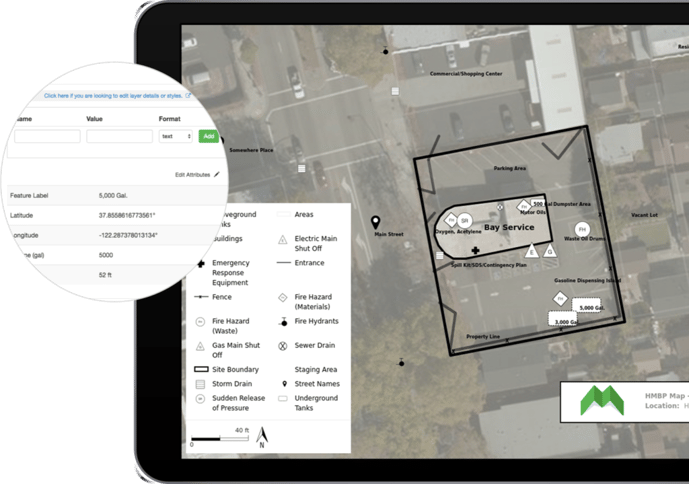
The mapping tool within the Hazardous Materials Suite provides instant access to update the HMBP map.
Summary
Well, there you have it, folks, the top 5 CUPA violations and how to avoid them! To put it all together: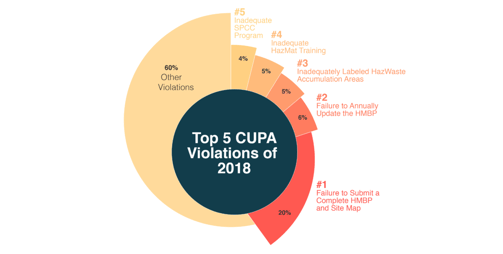
If you’d like a quick summary of the most common violations to check that your facilities meet the basic regulatory requirements, click to download our 1-page summary of the top 5 CUPA violations.
As online reporting tools like CERS become more and more prevalent, public access to facility violations and enforcement actions is becoming the norm. Companies that adopt technology safeguard compliance and proactively prevent violations.



%201%20(2).png)
.png)
.svg)
